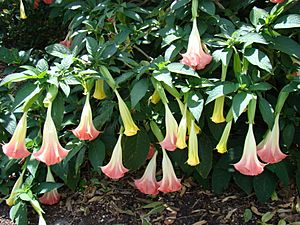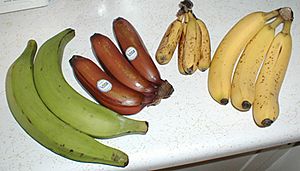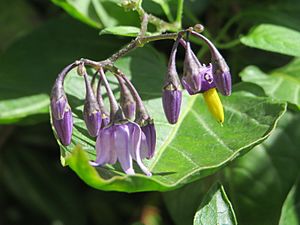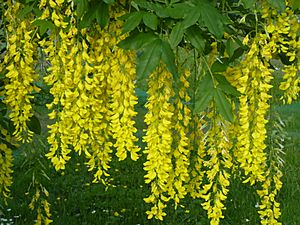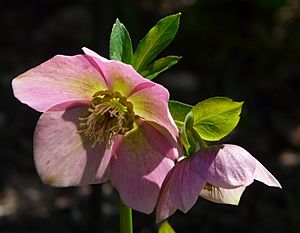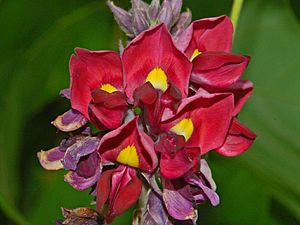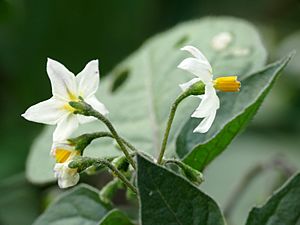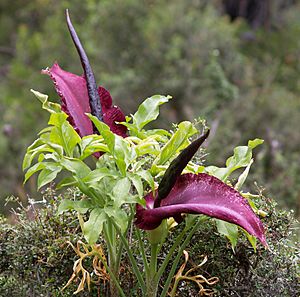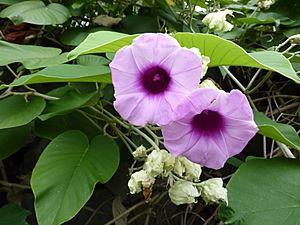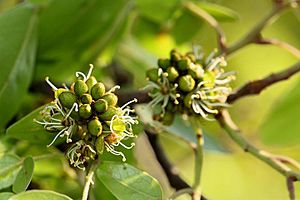List of plants by common name facts for kids
Plants have many different names, which can sometimes be confusing! This article will help you understand why. Plants often have a common name, which is what most people call them in everyday talk. Think of names like "apple" or "banana."
However, these common names can change a lot depending on where you are in the world. For example, what one person calls a "black alder" might be called something else by someone in another country. To avoid this confusion, scientists use a special system called binomial nomenclature, which means "two-name naming." Every plant has a unique scientific name, usually in Latin, that is understood by scientists everywhere. This is like a plant's unique ID card!
Contents
- Why Scientific Names Matter
- Exploring Plant Names: A-Z Examples
- A: Alders and Apples
- B: Bananas and Birches
- C: Cabbage and Cherries
- D: Dogwoods and Durians
- E: Orchids and Eucalyptus
- F: Ferns and Figs
- G: Garlic and Golden Chain
- H: Hellebores and Hollies
- I: Indian Paintbrush and Ivy
- J: Jasmine and Junipers
- K: Kudzu and King Ferns
- L: Lavender and Lilies
- M: Maples and Milkweeds
- N: Nettles and Nightshades
- O: Oaks and Oranges
- P: Pines and Poppies
- R: Roses and Raspberries
- S: Snowdrops and Sunflowers
- T: Thistles and Tobacco
- V: Violets and Voodoo Lilies
- W: Willows and Winterberries
- Y: Yarrow and Yellowwood
- Z: Zebrawood and Zedoary
Why Scientific Names Matter
Imagine you're talking about a plant called "dogwood." In one place, this might mean the beautiful Cornus florida tree. But in another, it could be a different plant entirely! Scientific names solve this problem. Each plant gets a unique two-part name. The first part is the genus (a group of similar plants), and the second part is the species (the specific type of plant).
For example, the common apple is known scientifically as Malus domestica. No matter where you are, if you say Malus domestica, everyone knows exactly which plant you mean. This helps scientists, farmers, and even gardeners around the world communicate clearly about plants.
Exploring Plant Names: A-Z Examples
Let's look at some interesting plants and their names, both common and scientific.
A: Alders and Apples
Alder trees are a good example of how common names can vary. While their scientific name is Alnus, you might hear them called "black alder" (Alnus glutinosa or Ilex verticillata), "gray alder" (Alnus incana), or "white alder" (Alnus incana or Ilex verticillata). It shows how one common name can refer to different plants, or one plant can have many common names!
The Angel trumpet is a beautiful flower known scientifically as Brugmansia suaveolens. It gets its common name from its large, trumpet-shaped flowers.
Apples are a fruit almost everyone knows! Their scientific name is Malus domestica. This name helps us know we're talking about the fruit we eat, not just any tree.
B: Bananas and Birches
Bananas are a popular fruit, mainly from the plant Musa × paradisica. There are many different types, or "cultivars," of bananas, but they all fall under the Musa genus.
Birch trees, scientifically known as Betula species, also have many common names. You might hear "paper birch" (Betula papyrifera), famous for its peelable bark, or "sweet birch" (Betula lenta), which has a wintergreen scent. Other names include "river birch" (Betula nigra) and "yellow birch" (Betula alleghaniensis).
C: Cabbage and Cherries
Cabbage (Brassica oleracea) is a common vegetable. But did you know that "skunk cabbage" (Symplocarpus foetidus) is a completely different plant? It gets its name because it smells like a skunk! This is a great example of why scientific names are so important.
Cherries are delicious fruits from the Prunus group of trees. Common names include "black cherry" (Prunus serotina) and "wild cherry" (Prunus avium).
The Columbine flower (Aquilegia vulgaris) is known for its unique shape, which some say looks like a group of doves.
D: Dogwoods and Durians
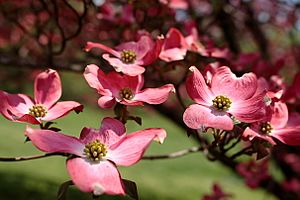
Dogwood trees (Cornus species) are well-loved for their beautiful flowers. The "flowering dogwood" (Cornus florida) is a popular type, especially in spring. Other dogwoods include the "silky dogwood" (Cornus amomum).
Durian (Durio zibethinus) is a famous fruit, especially in Southeast Asia, known for its strong smell and unique taste. There are many types, like "red durian" (Durio dulcis).
E: Orchids and Eucalyptus
The Easter orchid (Cattleya schroederae) is a beautiful flower, often blooming around Easter time.
Eucalyptus trees (Eucalyptus species) are mostly found in Australia. They are known for their distinctive scent and are a favorite food for koalas.
F: Ferns and Figs
Fellenwort (Solanum dulcamara), also known as "bittersweet" or "climbing nightshade," is a plant with pretty flowers and berries, but its common names hint that it can be poisonous.
Ferns are ancient plants that reproduce with spores instead of seeds. There are many types, like the "Boston fern" (Nephrolepis exaltata) and the "Christmas fern" (Polystichum acrostichoides). "Mosquito fern" (Azolla caroliniana) is a tiny fern that floats on water.
Figs (Ficus species) are fruits from trees like the "common fig" (Ficus carica). They are sweet and often eaten dried.
G: Garlic and Golden Chain
Garlic (Allium) is a plant used in cooking. There's "wild garlic" (Allium canadense) and "golden garlic" (Allium moly), which has pretty yellow flowers.
The Golden chain tree (Laburnum) is famous for its long, hanging clusters of bright yellow flowers that look like golden chains.
H: Hellebores and Hollies
Hellebores (Helleborus species) are often called "winter roses" because they bloom in late winter or early spring. Be careful, as some hellebores like Veratrum viride (American white hellebore) are poisonous.
Holly (Ilex species) is well-known for its shiny green leaves and bright red berries, especially around the holidays. Different types include "European holly" (Ilex aquifolium) and "winterberry holly" (Ilex verticillata), which loses its leaves but keeps its berries in winter.
I: Indian Paintbrush and Ivy

Indian paintbrush (Castilleja) is a wild flower with colorful, brush-like blooms that look like they've been dipped in paint.
Ivy (Hedera species) is a climbing plant often seen growing on walls or trees. "Common ivy" (Hedera helix) is the most well-known type.
J: Jasmine and Junipers

Jasmine (Jasminum officinale) is a plant famous for its sweet-smelling flowers, often used in perfumes and teas.
Juniper trees (Juniper species) are evergreen trees or shrubs. Their berries are used to flavor gin and other foods.
K: Kudzu and King Ferns
Kudzu (Pueraria montana) is a fast-growing vine, sometimes called "the vine that ate the South" in the United States because it grows so quickly and covers everything.
The King fern (Ptisana salicina) is a very large and impressive fern, living up to its royal name.
L: Lavender and Lilies
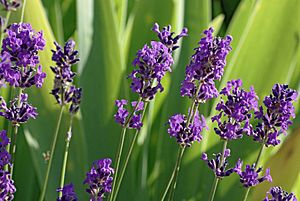
Lavender (Lavandula) is a fragrant plant known for its purple flowers and calming scent. It's used in soaps, oils, and even cooking.
The Leopard lily (Lilium catesbaei) is a beautiful lily with spotted petals, making it look like a leopard's coat.
M: Maples and Milkweeds
Maple trees (Acer species) are famous for their beautiful fall colors and for producing maple syrup. Common types include "sugar maple" (Acer saccharum), "red maple" (Acer saccharinum), and "silver maple" (Acer saccharinum).
Milkweed (Asclepias species) is a very important plant for monarch butterflies, as it's the only plant their caterpillars eat. "Common milkweed" (Asclepias syriaca) and "butterfly weed" (Asclepias tuberosa) are two well-known types.
The Petty morel (Solanum nigrum) is also known as "black nightshade." While some parts of this plant can be toxic, the ripe berries of some types are edible.
N: Nettles and Nightshades

Nettles (Urtica dioica) are plants known for their stinging hairs. Be careful when you touch them!
Nightshade is a common name for many plants in the Solanum family. Some, like "deadly nightshade" (Solanum nigrum), are very poisonous, while others, like tomatoes and potatoes, are safe to eat. This is another reason why scientific names are so important for safety!
The Native fuchsia (Epacris longiflora) is a beautiful Australian plant with long, tubular flowers.
O: Oaks and Oranges
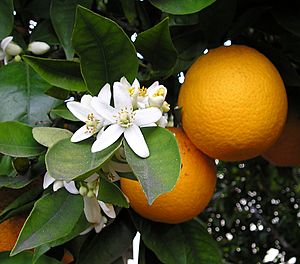
Oak trees (Quercus species) are strong, long-lived trees that produce acorns. There are many kinds, like "white oak" (Quercus alba), "red oak" (Quercus rubra), and "cork oak" (Quercus suber), which is where cork comes from.
The sweet orange (Citrus × sinensis) is the fruit we all know and love. The "Osage orange" (Maclura pomifera) is a completely different tree that produces large, bumpy, green fruits that look like oranges but are not edible for humans.
P: Pines and Poppies
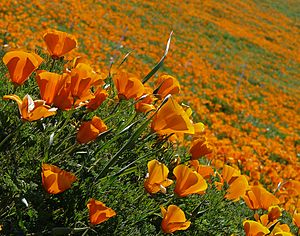
Pines (Pinus species) are evergreen trees with needles and cones. They are common in many forests around the world.
Poppies (Papaveraceae family) are known for their colorful, often delicate flowers. The "California poppy" (Eschscholzia californica) is the state flower of California, famous for its bright orange blooms.
R: Roses and Raspberries
Raspberries (Rubus species) are delicious berries. "Black raspberry" (Rubus occidentalis) is a popular type.
Roses (Rosa species) are one of the most popular flowers, known for their beauty and fragrance. There are many varieties, including "wild rose" (Rosa virginiana) and "multiflora rose" (Rosa multiflora).
S: Snowdrops and Sunflowers
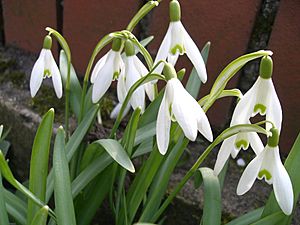
Snowdrops (Galanthus) are small, white flowers that are often among the first to bloom in late winter, even pushing through snow.
Sunflowers (Helianthus annuus) are famous for their tall stems and large, bright yellow flowers that follow the sun. Their seeds are a popular snack!
T: Thistles and Tobacco
Thistles are spiky plants, often considered weeds. "Canada thistle" (Cirsium arvense) is a very common type.
The Tobacco plant (Nicotiana) is known for its leaves, which are used to make tobacco products. "Tree tobacco" (Nicotiana glauca) is a type that can grow quite tall.
V: Violets and Voodoo Lilies
Violets (Viola species) are small plants with pretty, often purple, flowers. "African violet" (Saintpaulia) is a popular houseplant.
The Voodoo lily (Dracunculus vulgaris) is a fascinating plant known for its large, unusual flower that has a strong, unpleasant smell, attracting insects for pollination.
W: Willows and Winterberries
Willows (Salix species) are trees often found near water. They are known for their flexible branches. "Red willow" (Cornus amomum) is one type.
Winterberry (Ilex verticillata) is a type of holly that loses its leaves in winter but keeps its bright red berries, providing color when other plants are bare.
The Woolly morning glory (Argyreia nervosa) is a beautiful climbing vine with large, heart-shaped leaves and funnel-shaped flowers.
Y: Yarrow and Yellowwood
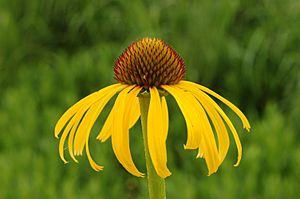
Yarrow (Achillea species) is a common wildflower with clusters of small flowers. "Common yarrow" (Achillea millefolium) is often found in fields.
Yellowwood (Cladrastis lutea) is a tree known for its yellow wood, which was once used to make yellow dye.
Z: Zebrawood and Zedoary
Zebrawood (Brachystegia spiciformis) is a tree known for its beautiful wood, which has dark stripes that look like a zebra's pattern.
Zedoary (Curcuma zedoaria) is a plant related to ginger and turmeric. Its roots are used in cooking and traditional medicine.
|


